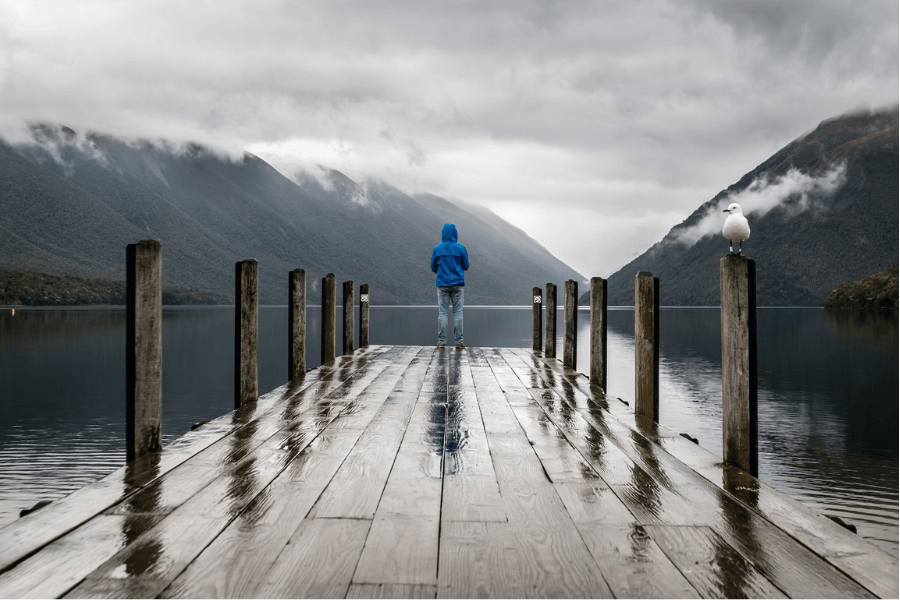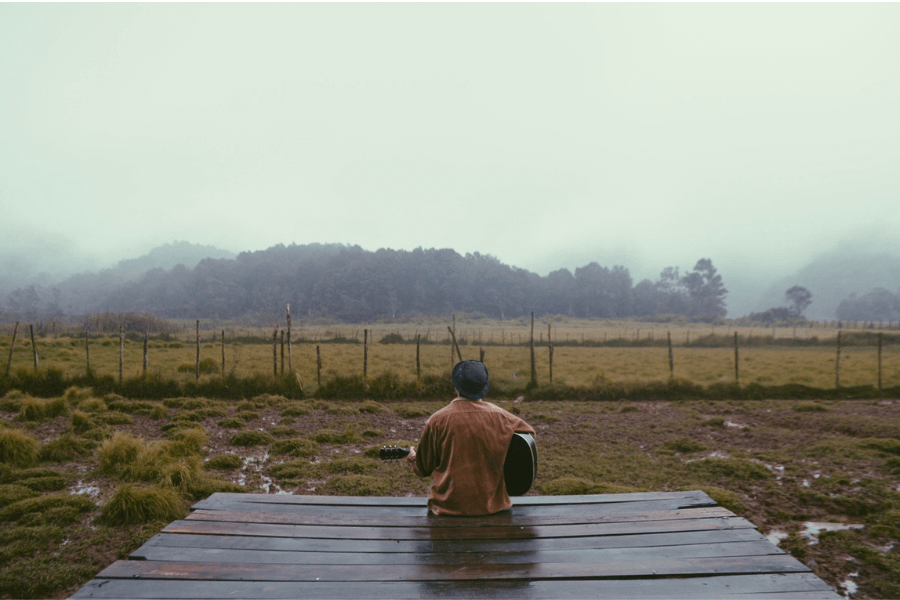Enjoy the outdoors even in the autumn rain
Hiking in the autumn rain certainly has many disadvantages, but why not focus on the benefits? One of the major advantages of hiking in the rain is that this time you will be alone in nature, or just with the person you are hiking with.
Wandering through the nature in rainy and unpleasant weather can offer you a whole new angle on places you may already know from days when it was sunny. Back then, there were probably more people, but also a different mood - and who says a "weepy", melancholic mood can't be pleasant?
Go "around the fence"
If you have no experience with walking in autumn rain, you should initially take a shorter route around your home that you know well. Don't try any extreme hiking or multi-day ridge crossings as a beginner. First you need to experience how a rainy day is different from a sunny one.
You may be surprised by soggy ground, you may find that your current equipment doesn't suit you (or the outdoor conditions), you may eventually discover that rainy weather is not for you and you'd rather spend it by the fireplace or radiator with a warm cup of coffee in your hand.
But you're more likely to love being outside on a rainy autumn day. It's really all about your attitude. If you tell yourself it's worth it, smile at the clouds and get excited about the discoveries that nature around us provides more than enough of, then you'll probably enjoy a rainy day too.

If you tell yourself that the outdoors in the rain is worth it, you'll smile at the clouds too.
You're gonna get wet, get over it.
But even the best and most expensive outdoor equipment cannot promise miracles. If it rains all day, you have to accept that you will be wet by the end of the day. Here we should briefly review some terms that are related to functional clothing. Specifically, let's talk about the outer layer, which should be breathable on the inside while repelling water on the outside.
The level of water repellency is determined by the so-called water column, which, in simple terms, tells us, how much water can get on the jacket or pants before they "soak through". Naturally, the higher this number is, the more effectively the item of clothing will fight water.
And breathability or permeability? This determines how effective the fabric is at evaporating sweat and condensed moisture from the inside. It is because of the (lack of) breathability that we definitely do not recommend using a raincoat instead of a jacket, at least not in the long term. A raincoat is simply made of a material that hasn't been given breathability and you would be "swimming in your own juices" after a few hours.
Because of the above, avoid single-layer nylon or polyester, which are the materials that generally have the lowest water column and are more suited for single-purpose wind-cheaters than rain jacket or waterproof pants. Then there is woven or membrane softshell, where the waterproofness and breathability are a bit higher again. But it's best to use a tent membrane material such as hardshell or Gore-Tex.
But even Gore-Tex gets wet after a while, especially if it rains all day and intensively. Therefore, you should make a plan for the evening, how to keep warm, how to take shelter and how to spend at least the night as dry as possible - if you are going to spend the night outside.

Don't underestimate rain equipment, especially in cold weather.
Get ready for drying
It is one thing to spend the whole day walking in the rain and another to have to spend the evening and night in the same damp conditions. That's why it's wise to equip yourself ahead of time so that you're prepared to dry out and warm up.
An invaluable helper will be the tarp. In autumn, it is more convenient to sleep in a tent (you can pack one too), but a tarp is more practical for evening preparations. You can build a fire under it to dry your wet clothes and equipment.
If you make a shelter out of a tarp, then you can easily make a fire under it. Of course, don't build a fire in the woods, although there's no danger of it catching fire in the rain, even after a few hours of rain. On the contrary, you will have a problem to start the fire itself. Try to find at least a little dry bush wood somewhere under overhangs or in the lower levels of the forest, then stack it under the tarp and light the fire with a combination of, for example, an alcohol lighter and flint or waterproof matches.
It is also advisable to bring a mess-tin and field cooker to heat water so that you can make soup or hot tea in the evening. The drizzle and early darkness outside are not good for the mental health, but the warmth from outside and inside can improve your mood.
Protect your equipment
As for rain, don't underestimate even the light ones. Your backpack may be water-repellent, but at the very least, the seams will leak over time and the gear inside will get wet. This is a problem for several reasons - if you have precious photography equipment or electronics in your backpack, you can easily lose them. And if you have dry clothes and a sleeping bag in there, then know that these items get wet easily, but are even harder to dry.
It is therefore advisable to equip yourself in advance and get a backpack raincover. This provides a high water column and thus protects the equipment inside from getting wet. If you haven't got a raincover yet, or forgot to pack one, you can use a temporary solution in the form of plastic and waste bags to line the inside of the backpack.
But this is really a temporary solution, because it brings with it a lot of compromises - a garbage bag is by its very nature not breathable, and if you accidentally put something wet in it, it can soon start to condense and start to degrade other, still dry parts of the equipment.
If it's going to rain a lot and you don't trust your backpack raincover, then we recommend you equip yourself with waterproof covers – at least wrap your electronics in them. Waterproof covers can save you quite a bit of value.

In rainy weather, you will meet a minimum of people outside.
Protect yourself
We've already talked a bit about rainwear above, but such clothing needs to be taken care of - especially with sufficient Waterproofing. If you find that you haven't impregnated your jacket or trousers for a long time, then it's a good idea to impregnate them before you travel. Waterproofing consists of saturating the otherwise absorbent material with (mainly) aerosol spray. Raindrops will then soak less into the clothing material and will run downwards more.
Your footwear also deserves a suitable impregnation because shoes should naturally be adapted to being outside in more demanding conditions. However, one of the weakest points of your personal protection against water is located between the pants and the shoes. We therefore recommend equipping yourself with sleeves, that act as another protective layer in the area of this transition.
We recommend that you also pack a combination of raincoat and poncho for the rain. While this piece of clothing tends to be impermeable (or only minimally breathable), as we've already discussed, it can protect us and our backpack, and after all, we'll only be wearing it directly on our jacket just on the shoulders. It will continue to "blow up" from below.
Watch out for your mental health
During multi-day hikes in the autumn rains, it is more important than ever to maintain a positive (or at least slightly neutral) attitude. The best way to boost your mental health is to go with more than one person (but beware of querulous and negative fellow hikers).
But the mental health and the physical state are quite related. Therefore, if you sleep well, eat enough and, most importantly, stay dry, you will have a lot less reasons to have a full moon. You should be especially dry in the evening and at night. If you find only one dry t-shirt or shorts in your backpack some mornings, then put on wet ones. It may not be the ideal solution, but you'll stop noticing the temporary discomfort after a few miles of walking... and in the evening, it will be like Xmas to find those dry bits in your backpack.
Readers are further interested
















































































